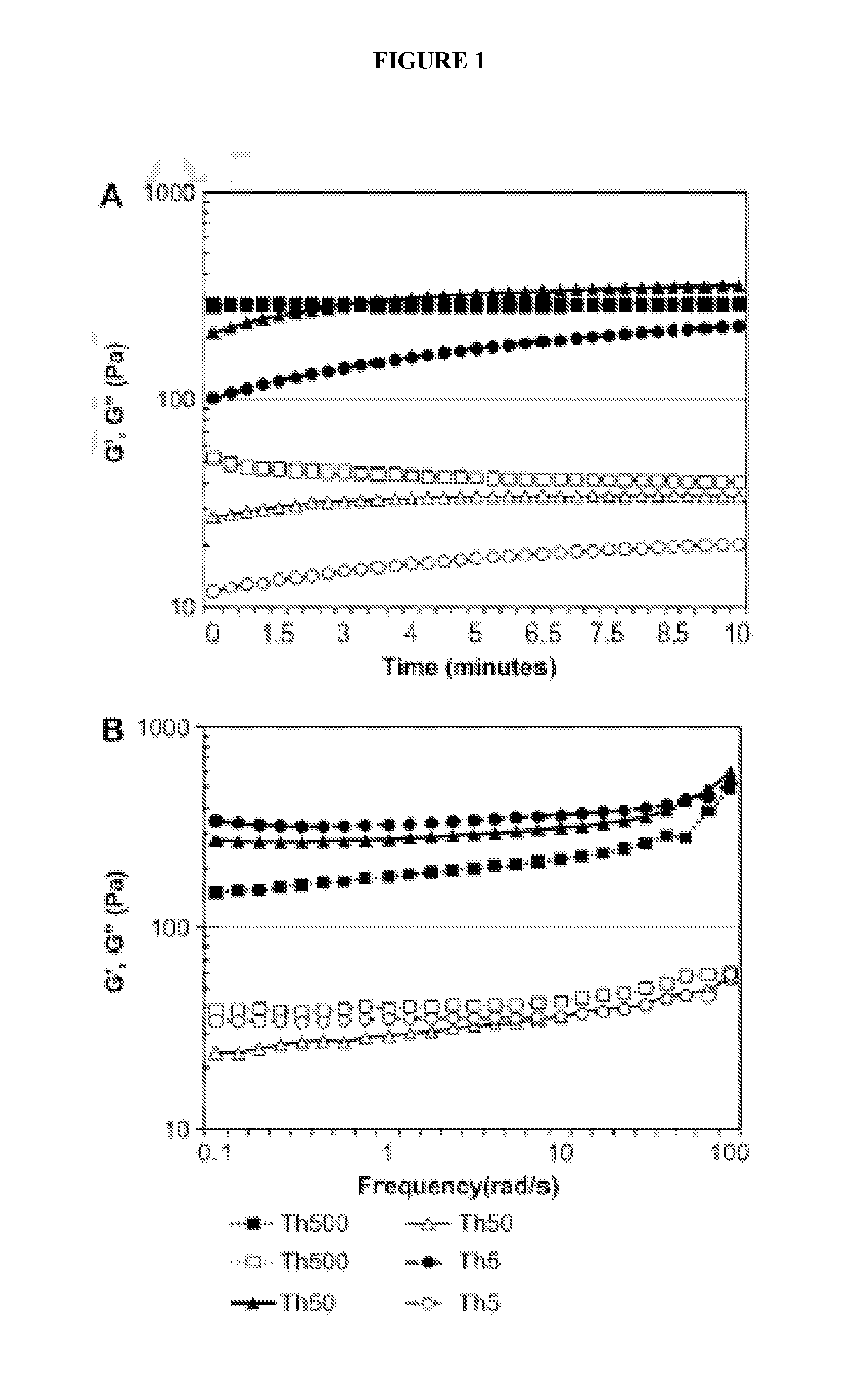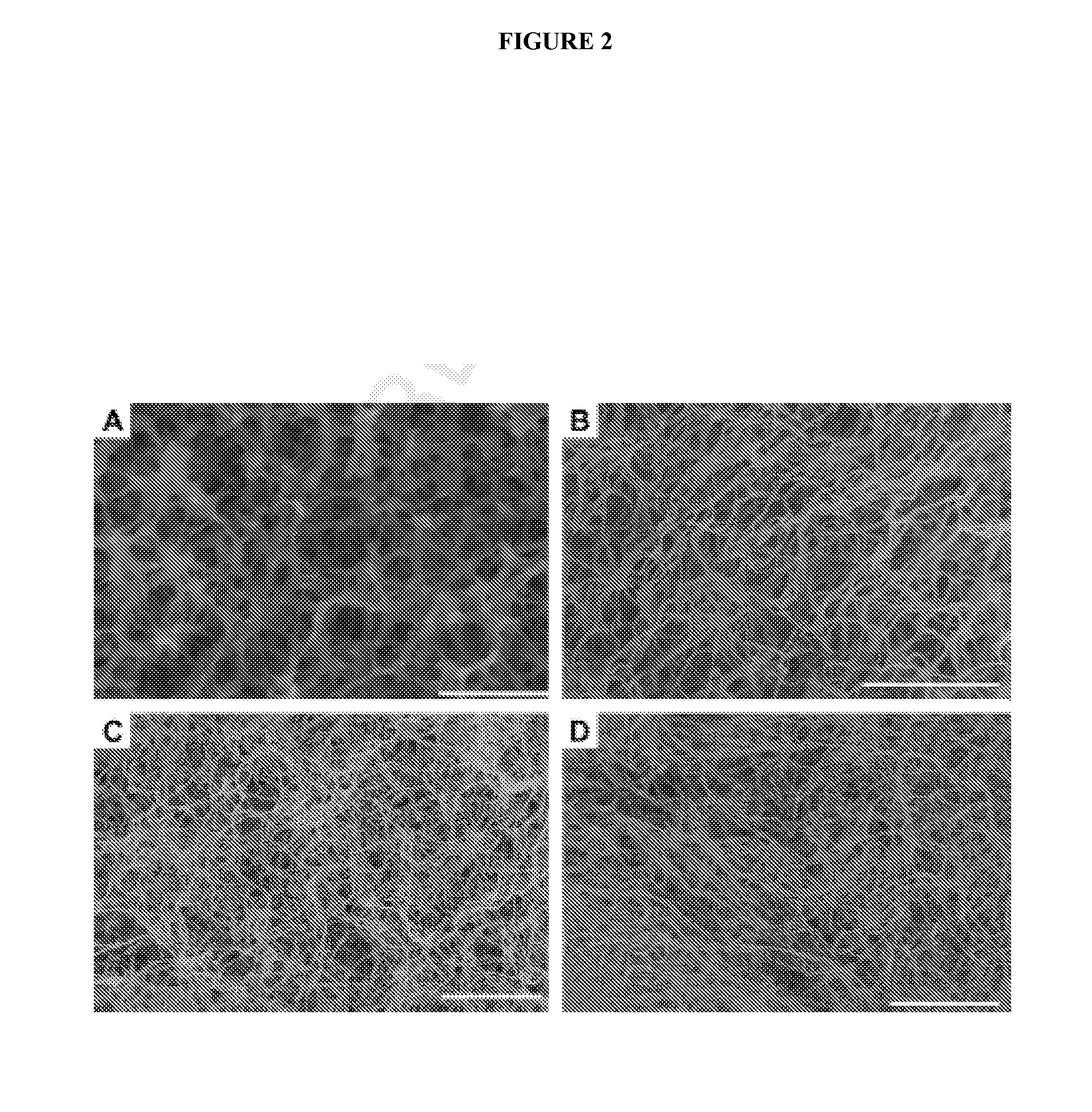Interpenetrating biomaterial matrices and uses thereof
a biomaterial and matrix technology, applied in the field of matrixes, can solve the problems of loss of female reproductive capacity, carries a risk of reintroducing malignant cells, and is not suitable for adolescent and prepubertal girls, and achieves the effect of preventing fibrin degradation
- Summary
- Abstract
- Description
- Claims
- Application Information
AI Technical Summary
Benefits of technology
Problems solved by technology
Method used
Image
Examples
example 1
Interpenetrating Fibrin-Alginate Semi-Degradable Matrices for In Vitro Ovarian Follicle Development
A. Materials and Methods
[0064]Animals and Materials
[0065]Two-layered secondary follicles were mechanically isolated from 12-day-old female F1 hybrids (C57BL / 6j×CBA / Ca). Animals were purchased (Harlan, Indianapolis, Ind.), housed in a temperature and light controlled environment (12 L: 12 D) and provided with food and water ad libidum. Animals were fed Teklad Global irradiated 2919 chow, which does not contain soybean or alfalfa meal and therefore contains minimal phytoestrogens. Unless otherwise noted, all chemicals were purchased from Sigma-Aldrich (St. Louis, Mo.), stains and antibodies from MolecularProbes (Eugene, Oreg.), and media formulations from Invitrogen (Carlsbad, Calif.). Sodium alginate (55-65% guluronic acid) was provided by FMC BioPolymers (Philadelphia, Pa.) and Tisseel® fibril sealant product (Baxter Healthcare, BioScience Division, Westlake Village, Calif.), was used ...
example 2
In Vitro Cultured Preantral Follicles from Luteal-Phase Baboon Ovaries Produce Oocytes Competent for In Vitro Maturation and Fertilization
A. Materials and Methods
Ovary Collection
[0094]Ovaries were obtained from 6 adult cycling baboons during the luteal phase, days 7-10 post-ovulation (PO) (Table 4). Ovulation was detected by measuring peripheral serum levels of estradiol, beginning 7 days after the first day of menses. The day of the estradiol surge was designated Day −1, with Day 0 as the day of the ovulatory LH surge and Day 1 as the day of ovulation. Luteal-phase ovaries were confirmed by presence of a corpus luteum (CL). Ovaries were transported to the laboratory at room temperature and less than 1 hour after retrieval.
Cumulus-Oocyte-Complex (COC) Isolation and Classification
[0095]Ovaries were cut into quarters with a scalpel, and the medulla was separated from the cortex using curved scissors in MOPS-HTF medium (Cooper-Surgical, Trumbull, Conn.). COCs and preantral follicles we...
example 3
Tissue-Engineered Advance in the In Vitro Two-Step Culture of Early Stage Ovarian Follicles in Mouse
[0116]To develop an in vitro strategy to support the growth of early-stage follicles and produce mature oocytes competent for fertilization, whole ovaries from 8-day-old mice were cultured for 4 days, and then secondary follicles were isolated and cultured for 12 days in a three-dimensional alginate or fibrin-alginate (FA) hydrogel matrix. Analyses of outcomes included histologic evaluation of follicle development, steroid hormone production, and rates of oocyte maturation, oocyte fertilization, and embryo formation.
A. Materials and Methods
Animals
[0117]C57BL / 6j×CBA / Ca F1 hybrid mice study were housed and bred for the purposes of the study. Eight-day-old F1 female mice were used in this study. All animals were housed in a temperature- and light-controlled environment (12L:12D) and were provided with food and water ad libidum.
Organ Culture of 8-Day-Old Mouse Ovaries
[0118]As reported pre...
PUM
| Property | Measurement | Unit |
|---|---|---|
| Fraction | aaaaa | aaaaa |
| Concentration | aaaaa | aaaaa |
| Volume | aaaaa | aaaaa |
Abstract
Description
Claims
Application Information
 Login to View More
Login to View More - R&D
- Intellectual Property
- Life Sciences
- Materials
- Tech Scout
- Unparalleled Data Quality
- Higher Quality Content
- 60% Fewer Hallucinations
Browse by: Latest US Patents, China's latest patents, Technical Efficacy Thesaurus, Application Domain, Technology Topic, Popular Technical Reports.
© 2025 PatSnap. All rights reserved.Legal|Privacy policy|Modern Slavery Act Transparency Statement|Sitemap|About US| Contact US: help@patsnap.com



